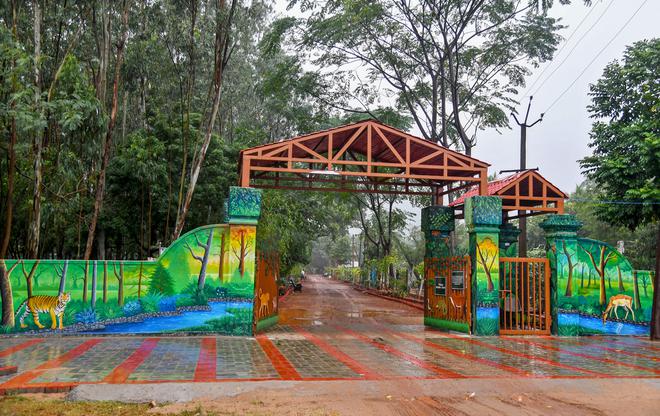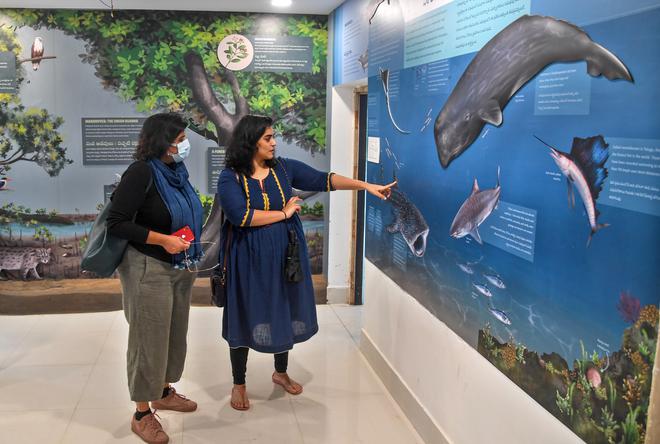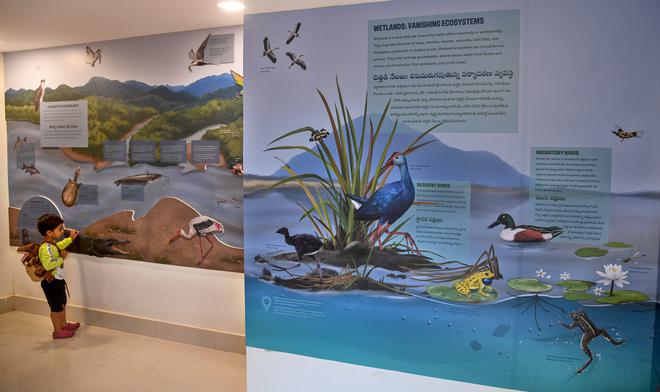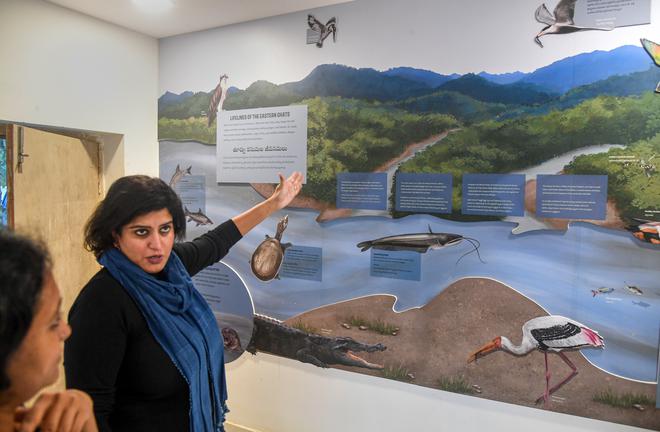A floor to ceiling map introduces visitors to the landscape of the Eastern Ghats, parallel to the eastern coast of India, stretching from Odisha to Tamil Nadu. A door ahead leads to a sun-lit room with a window facing the mountains, featuring water-colour sketches of iconic species of plants found in the region, including several that are found only within the Eastern Ghats. A few of these are severely threatened with extinction.
The new Nature Interpretation Centre, a separate section at the recently-inaugurated Eastern Ghats Biodiversity Centre near PM Palem, is an immersive experience of traversing through the diverse ecosystems of the region, that has long awaited a systematic documentation. Located along the periphery of the Kambalakonda Wildlife Sanctuary in Visakhapatnam, the centre is a first-of-its-kind art-led project of the Andhra Pradesh Forest Department.
The brainchild of Visakhapatnam Divisional Forest Officer Anant Shankar, each section offers visitors a multifaceted view highlighting the region’s natural wonders complemented by creative art displays.
A bilingual project in English and Telugu, the centre is an interesting collaboration among research, content and art, put together by a team consisting of Bengaluru-based wildlife artist Sangeetha Kadur and illustrators, sculptors, architects, wildlife biologists, translators and content creators from across India.

“This centre showcases the critical ecosystems of the Eastern Ghats and also shows the association of tribal communities with the forests. Divided into different sections in the ground and first floors, it throws light on marine, coastal and wetland ecosystems. The mangrove ecosystem replica is the highlight of the Nature Interpretation Centre,” says Anant Shankar.
Located in the first floor, the mangrove wall highlights the mangrove forest that stands like a wall of defense along the Andhra Pradesh coast protecting it from storms and cyclones. It also features creatures that inhabit them, including the elusive fishing cat. “We have recreated a scene from a mangrove forest and for realistic depiction, have brought roots from a mangrove forest. The wall also uses laser cuts for an extra dimension and an interesting visual perspective,” says Megha Moorty of RoundGlass Sustain, a social impact initiative that collaborated in the project.

The integration of art work and sculptures seamlessly blend into the surrounding landscape, inviting guests to contemplate the intricate relationship between art and Nature.
“The choice to use illustrations and art (over photographs) was deliberate. An artist has complete control over how to depict a space — to control the angle of the species, the background, the lighting. An artist is able to curate the scene. However, it comes with great responsibility to ensure the depictions are accurate and we highlight species that need our attention. Art also has the ability to draw people in, and hold their attention. It is not age-specific. Our hope is that this art project will inform, educate and inspire visitors to care about the rich biodiversity of the Eastern Ghats,” says Sangeetha. While most of the walls have digital illustrations pieced together to present the larger picture, two panels related to the flora of Eastern Ghats were illustrated in water-colour on paper by Sangeetha and Bengaluru-based artist Shilpashree, which was later scanned to be produced digitally along with the text.

The ground floor shines the spotlight on four of the most elusive and endangered species of the Eastern Ghats — the Indian pangolin, Mysore slender loris, Jerdon’s courser and Jeypore ground gecko. “ TC Jerdon, a British surgeon and naturalist, first recorded the Jerdon’s Courser in 1848 from the Eastern Ghats. However, for 85 years, it wasn’t seen and thought to be extinct, until it was rediscovered in 1986 in Kadapa district,” says Megha. The Indian pangolin is one of the most trafficked animal in the world, smuggled in India and across borders for its scales and other body parts that are wrongly believed to have medicinal uses.
Another special section is dedicated to forests and highlights the lesser-known facets of Kambalakonda Wildlife Sanctuary, which hosts dry evergreen forests, a highly-threatened and unique forest type seen only in Tamil Nadu and Andhra Pradesh in India.

The first floor has richly illustrated sections on river that highlights the four rivers – Mahanadi, Godavari, Krishna and Cauvery – that flow through the Eastern Ghats; an inter-tidal zone; a section dedicated to butterflies featuring their spectacular migration from Eastern to Western Ghats; and a marine and a ficus section.
In a small corner, the caves section is coming up that invites people to experience the low-light ecosystem in a sculpted room. This will showcase replicas of stalactites and stalagmites and different cave formations of the region, in an attempt to recreate the feeling one would get if they walked into a cave including its soundscapes. The section will focus on some of the lesser-known cave species and highlight their survival strategies in the challenging ecosystem that exists without light. Local sculptors have recreated the structures in the cave room.
While a majority of work at the Nature Interpretation Centre of the Eastern Ghats is over, the rest will be completed by the end of December. The place promises to be a haven where conservation, education and artistic expression converge., beckoning visitors to explore and cherish the enchanting tapestry of the Eastern Ghats.
The Eastern Ghats Biodiversity Centre near PM Palem (beside Vizag Conventions) is a full-fledged knowledge hub that has sections like a medicinal plant garden, an orchidarium, a library (coming up) that focuses on Nature literature, a ficus garden with 46 species and a one-its-kind Nature Interpretation Centre of the Eastern Ghats. Open from 9am to 5pm.







